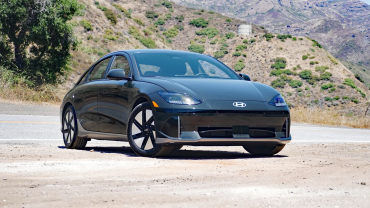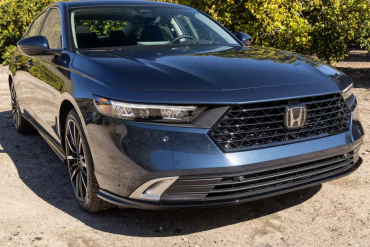Displaying items by tag: Sedan
2024 Hyundai Ioniq 6 Review: Best alternative to a Model 3
Futuristic sedan offers ample range, rapid charging and a great driving experience
The Ioniq 6 is the best of the E-GMP vehicles to drive, and its aerodynamic shape makes it super efficient with a long range. You give up utility versus the Ioniq 5, but the benefits will be worth it for some.
Pros: Fun, efficient driving; stand-out design; quick charging and ample range; well-executed safety tech
Cons: Too-cheap interior materials, especially in SE; some irritating controls; small trunk; max range tied to base trim
Crossover SUVs may rule the day, but there’s still a market for good old-fashioned sedans. Of course, there’s absolutely nothing else old-fashioned about the 2024 Hyundai Ioniq 6, an electric car that looks like it arrived in your driveway from the future. Indeed, its striking design is a key part of its appeal – and not just from an aesthetic standpoint. The ultra-aerodynamic shape contributes to exceptional efficiency and range, although the latter differs considerably based on motor and trim level. Perhaps a bit too much, as the only way to get the 361-mile max range is with the base SE trim and its excessively downmarket cabin.
Even those versions with less range, however, go much further than the typical EV and recharge much quicker. This is because the Ioniq 6 shares its E-GMP platform with the similarly gifted Hyundai Ioniq 5, Kia EV6 and Genesis GV60. Because the Ioniq 6 is a lighter, more aerodynamic car than those crossovers, though, it’s also the most athletic to drive on top of offering the best range and efficiency. We’ve consistently been surprised by how much fun can be had behind the Ioniq 6’s grippy two-spoke wheel. We also found it to be a highly capable and comfortable highway cruiser, blessed with a comfortable ride, quiet cabin and excellent driver assistance tech.
As much as we enjoy the Ioniq 6, its hangups are not insignificant. Interior quality is one, some frustrating controls are another. The trunk is also small for a sedan. Admittedly, all those issues also exist in the Ioniq 6’s main competitor: the Tesla Model 3. That has access to Tesla’s game-changing Supercharger network, however, along with lower prices (at least at the time of this writing), stronger acceleration and better range with all-wheel drive. Both are excellent choices, though, and prove there’s still life in the sedan market.
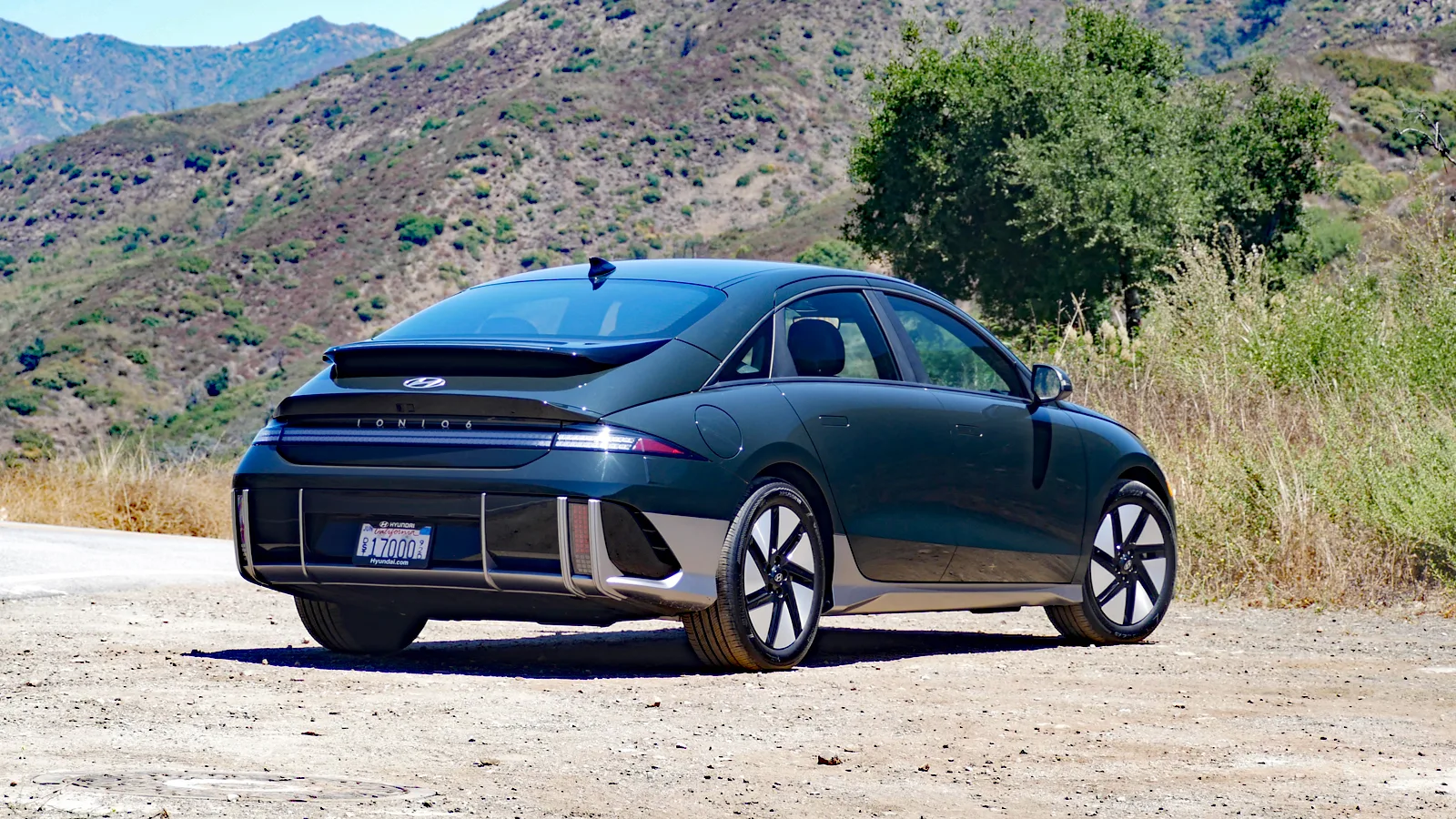
What's new for 2024?
The Ioniq 6 carries over unchanged for 2024.
What are the Ioniq 6 interior and in-car technology like?
The Ioniq 6 interior looks at first less bold than the streamlined exterior, but look closer, and it reveals itself to be one of the most creative cabins on the market. Though certainly reminiscent of the Ioniq 5, there are all kinds of unique details, such as the ripples on the doors that reflect the multi-color ambient light. Those doors are also distinctive in that they’re bereft of window and locking buttons. Those are on the center console, which admittedly takes some getting used to (unless you’ve owned a Jeep Wrangler or old BMW).
Materials quality also doesn’t look or feel as good as what you’d find in a Hyundai Sonata, for instance, or other midsize sedans. This is particularly evident in the base SE (pictured above in black), which is the only trim level available with the 361-mile range estimate. Its mandatory cloth trim looks and feels cheap, while the hard plastic phone bin will be a constant reminder that you didn’t opt for a high trim as your phone slides around without the benefit of wireless charging. You can read more about the Ioniq 6 SE interior here, but in general, we wish there were a way to get the max range with even a slightly nicer and better-equipped interior.
We recommend for you
In terms of functionality, the Ioniq 6 mostly succeeds. The dual 12.3-inch screens are bright, clear and responsive, while the infotainment interface is one of the easiest in the industry to use. The supporting touch-sensitive climate controls are less so, and we dislike the need to call up a touchscreen menu to engage the heated and ventilated seats or heated steering wheel. We also miss the “radio” shortcut button found in most other Hyundai and Kia vehicles – again, you have to press one button (“Media”) to bring up a touchscreen submenu. On the other hand, the fact that the Ioniq 6 has physical controls at all, plus instruments in front of the driver, stands in sharp contrast to its main rival, the Tesla Model 3 and its one-screen-does-everything interior.
How big is the Ioniq 6?
Like the other E-GMP cars, the Ioniq 6 is deceptively large. The short overhangs and unusual proportions make it seem like a small vehicle, but it's only a couple inches shorter than the Hyundai Sonata family sedan. The long wheelbase allows the interior to be particularly large, especially in regard to legroom. Surprisingly, the hunkered-down shape of the Ioniq 6 doesn’t overtly compromise visibility (it’s quite good, actually), while headroom up front remains decent despite a seating position that’s perhaps a smidge high. The seats are wide but a bit flat, and loads of adjustment makes it easy to find a comfortable seating position. Rear headroom is a little tight due to that distinct shape created for the sake of aerodynamic efficiency, but again, legroom is vast. Six-footers will have no problem sitting back-to-back, and you’ll have no problem with kids’ shoes kicking the passenger seat up front.
The trunk, on the other hand, is poor. Its volume of 11.2 cubic-feet would be small for a compact sedan, let alone a midsize one. Not surprisingly, the Ioniq 6 was unable to swallow all the bags of our standardized luggage test. By contrast, the Sonata’s 16.3-cubic-foot trunk had space left over for multiple bags. There is a substantial underfloor storage area, however, plus a frunk compartment perfectly sized to store the tire mobility kit and charge cord.
What are the Ioniq 6 electric range and performance specs?
The Ioniq 6 has three powertrain options, two of which are single-motor, rear-drive setups, and the third with two motors and therefore all-wheel drive.
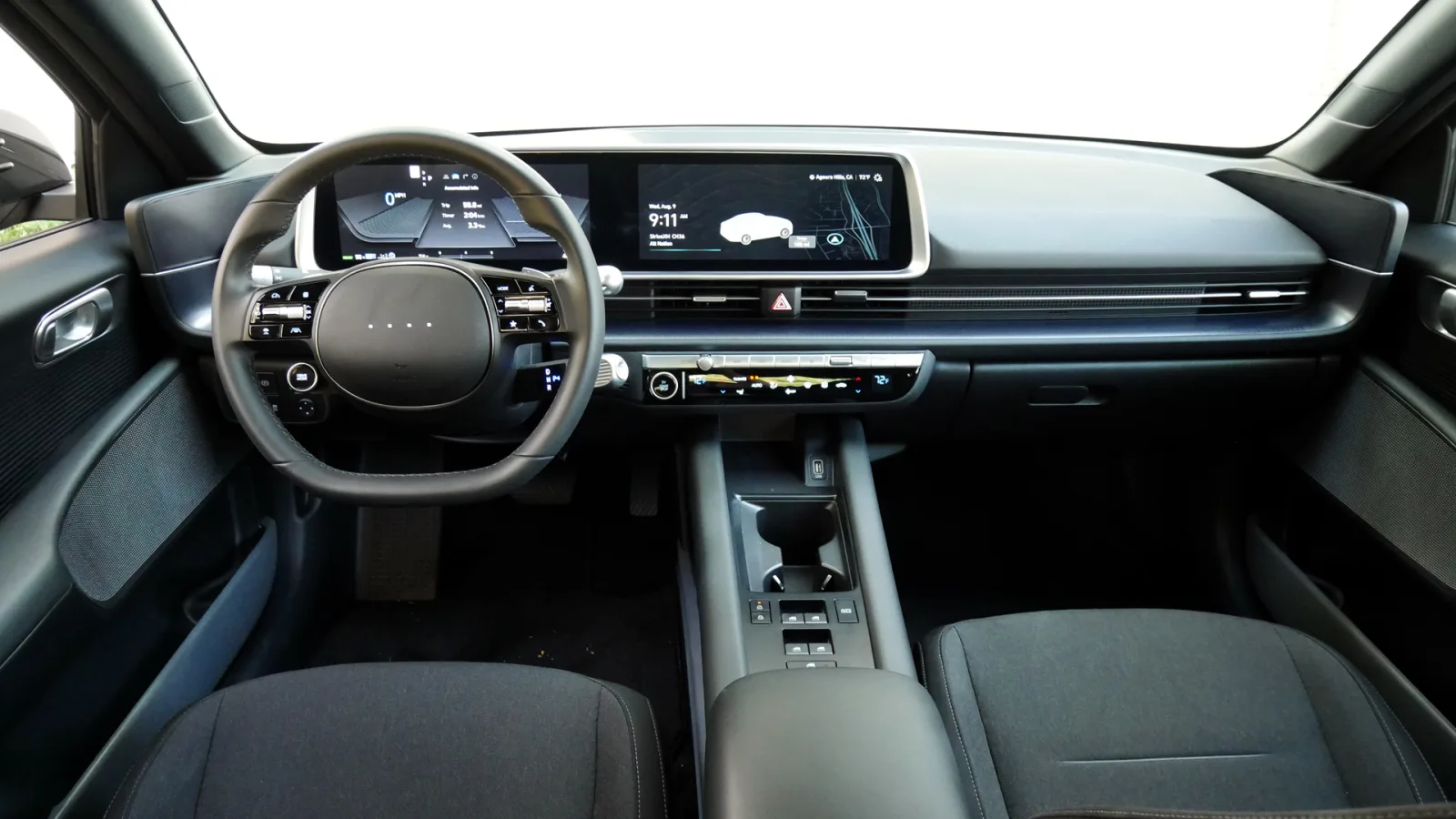
The first single-motor arrangement is exclusive to the SE Standard Range. It makes just 149 horsepower and 258 pound-feet of torque. It also gets the smallest battery, 53 kilowatt-hours, which returns an estimated range of 240 miles. It is quite efficient, coming in as the second-most frugal Ioniq 6 behind the long-range, rear-drive SE. Combined miles-per-gallon-equivalent is rated at 135.
Moving up to the other trim levels, the standard powertrain is the long-range, rear-drive option. It has a 77.4-kWh battery with higher output that allows for more horsepower from the rear motor: 225 horsepower. Torque remains the same at 258 pound-feet. That bigger battery offers better range, but the amount varies depending on the trim level. The SE has the best range at 361 miles, which is due to it being more efficient than the SEL and Limited on account of their larger wheels. The SE with rear drive returns 140 mpg-e combined. The SEL and Limited return 117 mpg-e and have a range of 305 miles.
Optionally available is the dual-motor, all-wheel-drive powertrain. With the addition of a front motor, power rises to 320 horses and torque to 446 pound-feet. Efficiency drops with the SE getting 121 mpg-e combined. Its range is 316 miles. The SEL and Limited get 103 mpg-e combined with a range of 270 miles.
Finally, lets talk charging speed. The Ioniq 6’s advanced 800-volt architecture allows it to swallow down electrons quicker than most other EVs. This greatly depends on the amount of kilowatts available at a fast charger, but all things being equal, we’d definitely rather have the faster-charging car available. The Ioniq 6 also charges very quickly at home, with 11-kW max speeds possible with an appropriate home charger.
What's the Ioniq 6 like to drive?
Interestingly, the Hyundai Ioniq 6 is the sportiest version of the E-GMP cars, apart from the high-performance Kia EV6 GT. The suspension is tuned stiffer, lending a much more responsive chassis with less body roll. The steering feels quicker and more accurate than its siblings, too. Selecting the heftier “Sport” steering mode really isn’t necessary.
The stiffer suspension does yield a correspondingly stiff(er) ride than its crossover(ish) cousins. That doesn’t mean it’s uncomfortable, though. Even on bigger wheels, we found it happily soaked up bumps and was an absolute highway champ during a road trip between Los Angeles and Las Vegas.
Acceleration is a big factor. We have yet to test the standard-range version, but given its meager 149 horses, we figure it’ll feel awfully slow even if it provides the usual initial electric kick off the line. The 225-hp extended-range rear-drive version certainly doesn’t provide the oomph of the 320-hp dual-motor Ioniq 6, but it also doesn’t feel slow. Unless you need the all-weather traction that all-wheel drive allows, we would stick with the extra range and lower price tag of the rear-motor/extended-range combo.
Also worth noting is that the Ioniq 6 has full one-pedal driving available. The regenerative braking force can be adjusted via the steering-wheel paddles, and at maximum, it can bring the car to a full stop. It's easily controllable, and the brake pedal feel and position remains consistent.
What is the 2024 Ioniq 6 price?
Think of the Ioniq 6’s pricing and feature content as breaking down into three columns, each tied with a different motor/battery combo. In the first there is the standard-range, rear motor combo only available in the base SE trim level. In the second is the extended-range, rear motor combo available in all three trim levels: SE, SEL and Limited. Finally, there’s the extended-range, dual-motor combo also available with all trims.
Keep in mind that there’s more to consider with your choice here than just getting your desired amount of equipment. Specifically, the dual-motor combo not only provides the all-weather assurance of all-wheel drive, it also carries with it a significant power increase along with a larger-than-usual price increase compared to gas-powered all-wheel-drive vehicles. It also loses electric range. Opting for the SEL and Limited also nets bigger wheels and therefore worse range.
All prices below include the $1,150 destination charge. No Ioniq 6 is eligible for a federal tax rebate, but there may be state-level rebates that apply.
SE RWD Standard Range: $38,650
SE RWD: $43,600
SEL RWD: $46,400
Limited RWD: $51,300
SE AWD: $47,100
SEL AWD: $49,900
Limited AWD: $54,800
What are the Ioniq 6 safety ratings and driver assistance features?
Every 2024 Ioniq 6 includes forward collision warning and automatic emergency braking with pedestrian and cyclist detection, lane-keeping assist, blind-spot and rear cross-traffic warning systems, Safe Exit warning (stops you from opening doors into cars or cyclists), driver inattention warning and adaptive cruise control with stop-and-go capability and lane-centering steering assist. The latter is known as Highway Drive Assist.
The SEL and Limited trims get Highway Drive Assist II, which adds partially automated lane changes (activate turn signal, car does the rest) and adapts itself to match your acceleration style. Those trims also add more proactive steering assistance for the forward collision and blind-spot warning systems. Finally, the Limited gains reverse automated braking, a surround-view parking camera system, remote smart parking using the vehicle remote, and a camera-based blind-spot monitor.
Besides the sheer volume of these systems, it’s important to note that they are among the best-executed in the automotive industry.
The Insurance Institute for Highway Safety named the Ioniq 6 a Top Safety Pick+, the highest honor available. Only its “Acceptable”-rated headlights got something other than a top mark in the many IIHS categories.
Source: autoblog.com
2023 Honda Accord Review: Among the Best of What’s Left
The verdict: The redesigned 2023 Honda Accord is better than its predecessor, though not by leaps and bounds, and remains one of the best choices in the dwindling mid-size sedan class.
Versus the competition: As more and more mid-size sedans are discontinued, the Accord soldiers on and solidifies its position as one of the best in its class, though it cedes aggressiveness and performance to (of all things) the Toyota Camry.
As we stopped to shoot photos and video of the new Honda Accord, what appeared to be a vulture circled overhead — an encapsulation of the state of the mid-size sedan class that’s perhaps a bit too on the nose. Notable models like the Volkswagen Passat and Mazda6 are discontinued, and the status of others seems tenuous at best as shoppers continue to display their preference for SUVs. But Honda doesn’t think the sedan is dead quite yet, and the new 11th-generation Accord is evidence of that.
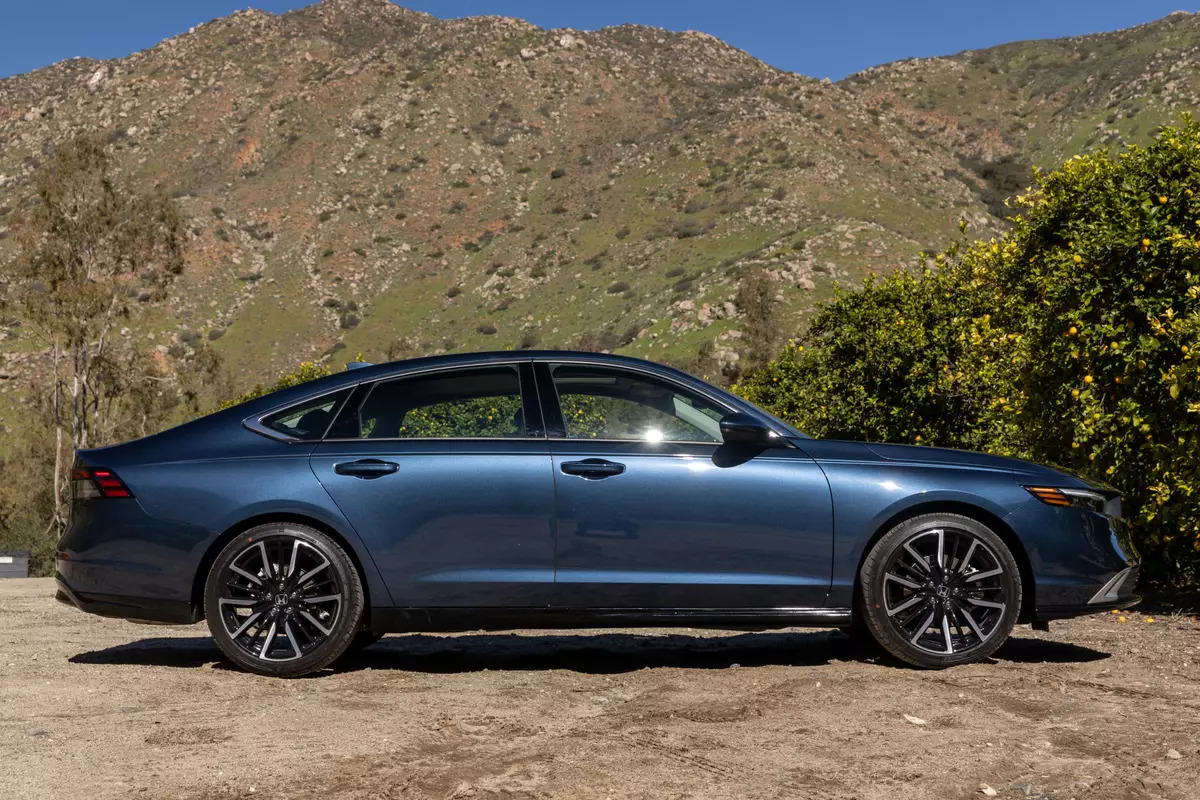
As part of its update, the Accord gets new styling that brings its looks in line with other Hondas. To my eyes, it looks like a big Civic, and I mean that as a compliment because I think the current Civic is one of the handsomest mainstream vehicles currently on sale. The automaker also eliminated the optional turbocharged 2.0-liter four-cylinder gas engine; buyers have a choice of a new hybrid powertrain using a 2.0-liter four-cylinder and two electric motors or an updated (but mostly carryover) turbo 1.5-liter four-cylinder engine and continuously variable automatic transmission. As with the redesigned 2023 CR-V compact SUV, however, the majority of 2023 Accords — and all Sport models — will come exclusively with the hybrid powertrain. All Accords also remain front-wheel drive even as all-wheel drive proliferates among competitors.
I traveled to Southern California for our first chance to drive the 2023 Accord and got to experience both the Sport and Touring hybrids as well as the gas-only EX (per Cars.com’s ethics policy, we pay for travel and lodging when attending such manufacturer-sponsored events). The good news for shoppers looking for a sedan is that the new Accord is better than its predecessor and one of the best choices in its class. The good news for buyers of the previous-gen Accord is that you shouldn’t feel buyer’s remorse — the improvements are mostly incremental.
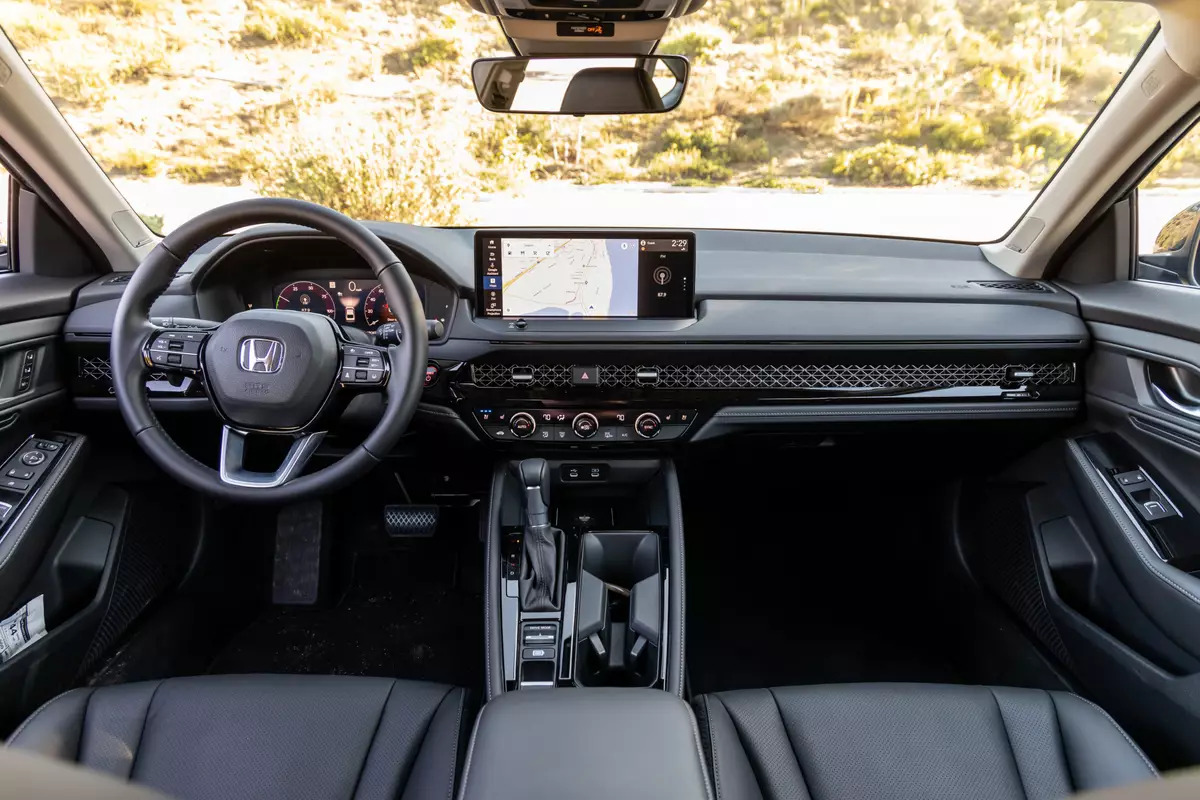
Easy and Mostly Pleasant to Drive
While “easy to drive” usually is faint praise — like a “very drinkable” beer — here it’s a compliment. Mid-size sedans should be comfortable, and the new Accord continues to excel in that regard. Hybrid versions have a system total of 204 horsepower and 247 pounds-feet of torque, and even though that includes models with the Sport designation, sportiness is not the Accord’s strong suit. The hybrid remains composed through corners with minimal but noticeable body roll, as well as little understeer despite its FWD configuration. According to Honda, the rear track is 0.4 inch wider, suspension tuning has been updated and the car is stiffer than the previous generation; none of that translates into significant handling improvements, but it is better. I do feel like some of my enjoyment of the Accord’s handling can be attributed to the simple fact that it’s a sedan in a market increasingly awash in SUVs; I love the feeling of sitting lower, and the car’s lower center of gravity compared with an SUV.
The Accord rides a bit firmly with the 19-inch wheels and low-profile tires that go on the Sport and Touring models I drove, but not so much that I found it truly objectionable. Steering, as in the previous generation, remains communicative and doesn’t feel overboosted; switching the drive mode into Sport adds extra artificial heft. Notably, the Sport and Touring trim levels had no noticeable difference in performance or dynamics. Accelerator pedal response is disappointing in hybrid mode, but power comes on more linearly when the powertrain is only using electric power. Like most hybrids, the gas engine is quick to join the party under brisk acceleration; I observed the best power delivery when cruising at highway speeds with the gas engine off before stepping on the accelerator to pass.
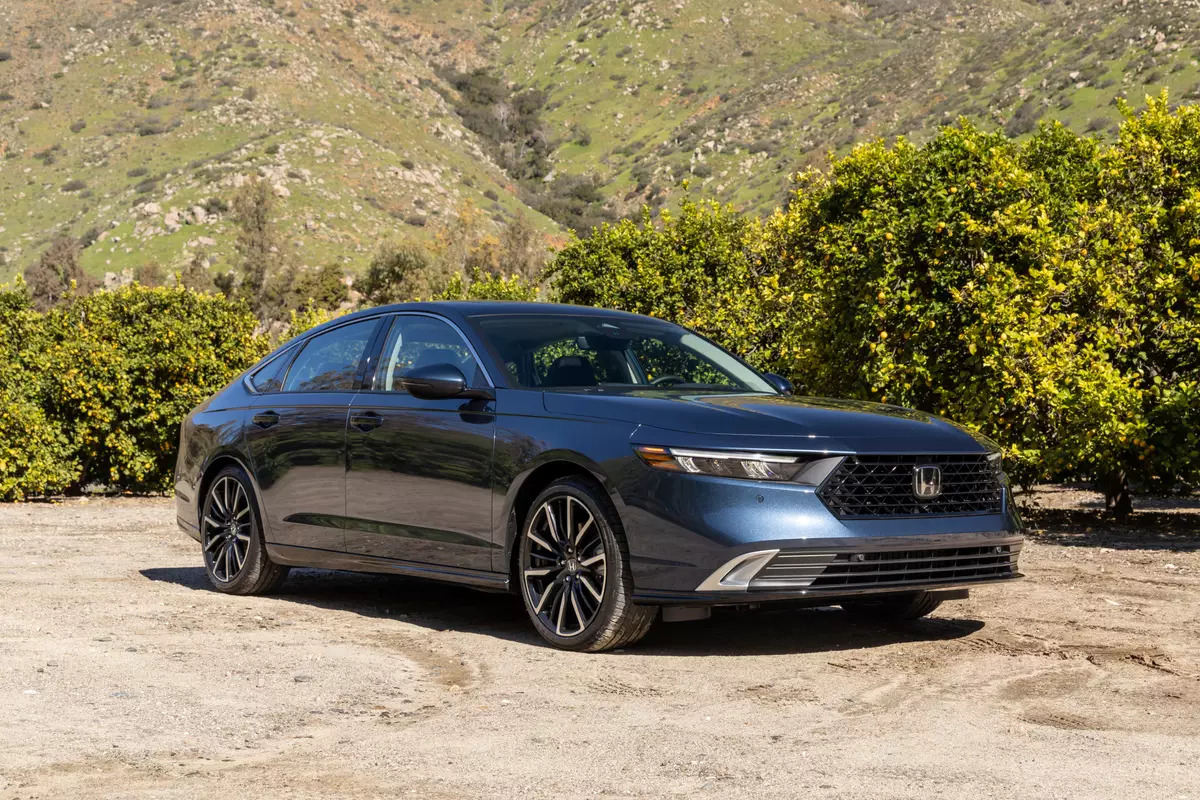
Instead of shifting, the paddles mounted on the steering wheel adjust the Accord Hybrid’s regenerative-braking strength. At their strongest level, the regen brakes allow for near-one-pedal driving. The brakes are a bit grabby initially, but they’re fairly easy to modulate otherwise. The regenerative brakes are also useful for controlling downhill speeds. At the lowest setting, which requires full use of the brake pedal, braking feel is linear and confident without any of the mushy or vague feel that often plagues hybrids.
The gas-only EX trim I drove had a better-cushioned ride — it gets 17-inch wheels and taller-sidewall tires — but it also felt less composed than either the Sport or Touring. Bumps and road imperfections that the Sport and Touring went over with just a firm impact upset the EX. Steering also felt vaguer, perhaps because of the different wheel-and-tire combination. Its 192-hp, turbocharged 1.5-liter four-cylinder engine is more refined, according to Honda, but any refinements compared to the previous generation flew under my radar. The powertrain is still noisy under hard acceleration and feels slower but more responsive than the hybrid.
Fuel economy becomes more important when a car commits to hybridization as much as the Accord does, and the good news is that new hybrid variants are more fuel-efficient than the old versions: Sport and Touring models are EPA-rated 44 mpg combined, up from the 10th gen’s 43 mpg; the Accord Hybrid is now rated as high as 48 mpg combined, also an increase of 1 mpg. The 2023 Toyota Camry Hybrid LE is rated far higher than the Accord Hybrid at 52 mpg combined, but other Camry Hybrids (rated at 46 mpg combined) sit in the middle of the Accord’s ratings. Gas-only Accords are rated 32 mpg combined, 1 mpg less than the last generation.
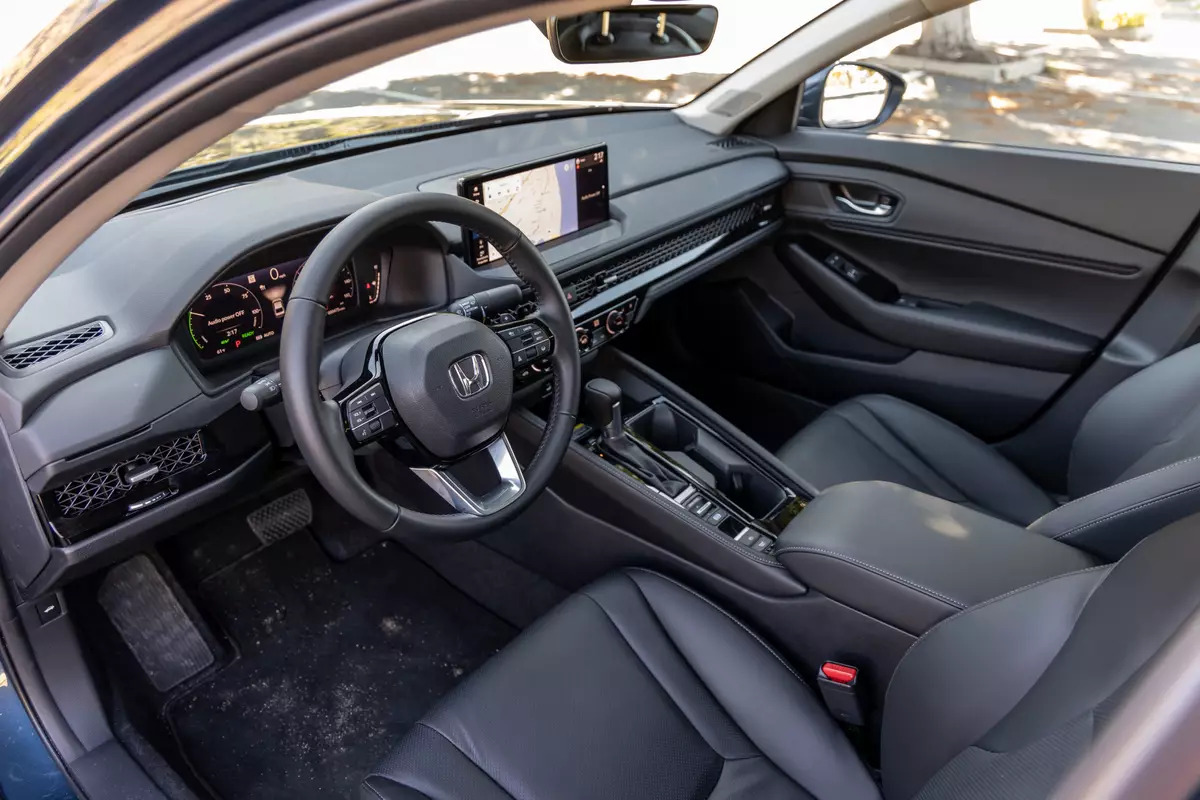
Better Interior, But Be Wary of Technology Creep
Grabbing headlines is the Accord’s newly available 12.3-inch touchscreen display and the inclusion of Google Built-In technology for the Touring. Excluding Google Built-In, the new system performs well with quick responses and crisp, clear graphics. Wireless Apple CarPlay and Android Auto are included with this display, and my use of wireless CarPlay worked flawlessly once connected. A bunch of automotive journalists using Bluetooth to connect to one of a line of cars can be a nightmare, it turns out, but connectivity worked fine apart from this rare scenario. Strangely, despite multiple trims having wireless Apple CarPlay and Android Auto, only the range-topping Touring comes with wireless device charging. It’s a confusing choice.
A more understandable decision — though also more frustrating — is the inclusion of Google Built-In for the Touring’s touchscreen. Many of the functions require a data connection to properly operate, meaning you may be out of luck if you’re somewhere without reliable cellular service. We’ve also had frequent issues getting the Google system to perform simple tasks, though I didn’t encounter them during this testing. Using voice commands for basic tasks like adjusting the in-car temperature worked fine, but in the time it took to say “Hey Google, change the temperature to 69 degrees,” have the command acknowledged and then executed, I could’ve easily done it myself; it feels like a solution for a problem that doesn’t really exist. With my phone connected to CarPlay, voice commands to place calls via Google Assistant were denied because of the CarPlay connection; I had the choice of disconnecting the phone from CarPlay or using Siri to place a call via voice command.
There’s a physical volume knob in front of the dashboard touchscreen, but unlike other, older Honda touchscreens, track and tuning adjustments are touchscreen-exclusive; older systems at least have buttons for those functions. Climate controls are, blessedly, physical buttons and knobs, and they feel high-quality to the touch. One more welcome physical control is the traditional gear selector lever instead of the push-button gear selector in prior models; the latter was fairly intuitive but also annoying, and it occupied roughly the same amount of space on the center console.
All 2023 Accords have a standard 10.2-inch digital instrument panel, which I’ve experienced and enjoyed in the 2023 Pilot SUV. My personal favorite feature is that the digital representation of the Accord in the center of the display shows when the taillights and turn signals are activated — helpful if you’re worried about the regenerative brakes illuminating the brakelights.
LX and EX trims get a 7-inch touchscreen along with volume and tuning knobs, but its small size relative to the larger screen left me a bit disappointed. Apple CarPlay and Android Auto are standard with this display, too, but require a wired connection. Those wired connections — at every trim level — are exclusively USB-C ports, with one for data connections and one for charging. (Higher trims add two more USB-C charging ports for rear passengers.) The Accord EX’s interior is also lacking in terms of materials quality when compared with higher trims, but it still felt well built.
As with other newer Hondas, the Accord’s forward visibility is improved because its front roof pillars have been moved rearward as part of its exterior update. Front-seat comfort is acceptable and improved, but I found my right knee bumping into the center console often, which wore on me during a day of driving. The taller dashboard, however, gave me more vertical knee room than the previous model.
Honda says the new Accord has gained less than a half inch of rear legroom. I’ve never found the backseat in previous Accords lacking in that respect, but more is welcome. My biggest issue is that the sloping roof of the fastback-adjacent styling cuts into rear headroom. I’m 6-foot-1, and while I can sit upright in the backseat, my head will touch the ceiling. Trunk space appears adequate, but there aren’t any useful tricks beyond the common 60/40-split, folding backseat; underfloor storage is taken up by tools and the tire repair kit.
Safety
The 2023 Accord comes standard with the Honda Sensing suite of active-safety features. As of this writing, the car had not yet been tested by either the Insurance Institute for Highway Safety or the National Highway Traffic Safety Administration. New for 2023 is Traffic Jam Assist, which can operate at speeds up to 45 mph and keep the Accord centered in its lane at a prescribed following distance from a preceding vehicle.
Should You Buy an Accord?
Selfishly, my answer is yes, if only to ensure that larger sedans remain on sale for years. Forgetting my nefarious goals, if you’re in the market for a mid-size sedan there are few better choices than the Accord. It’s very businesslike and no-nonsense in its approach, and hybrid versions are impressively efficient. For a more aggressive (and possibly more fun-to-drive) sedan in this class, you might want to consider a Toyota Camry instead. While the Accord isn’t necessarily the cheapest of the bunch, it’s very well rounded and felt worth its sticker price — whether it was the just-over-$30,000 EX, the almost-$34,000 Sport or the almost-$39,000 Touring. The sedan isn’t dead just yet, and the Accord is a solid choice in a dwindling field.

